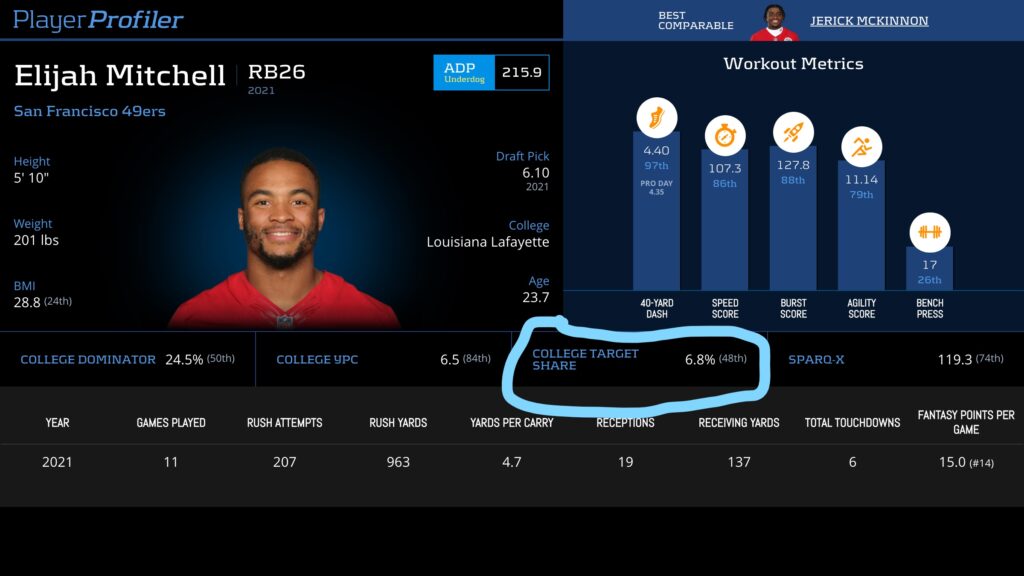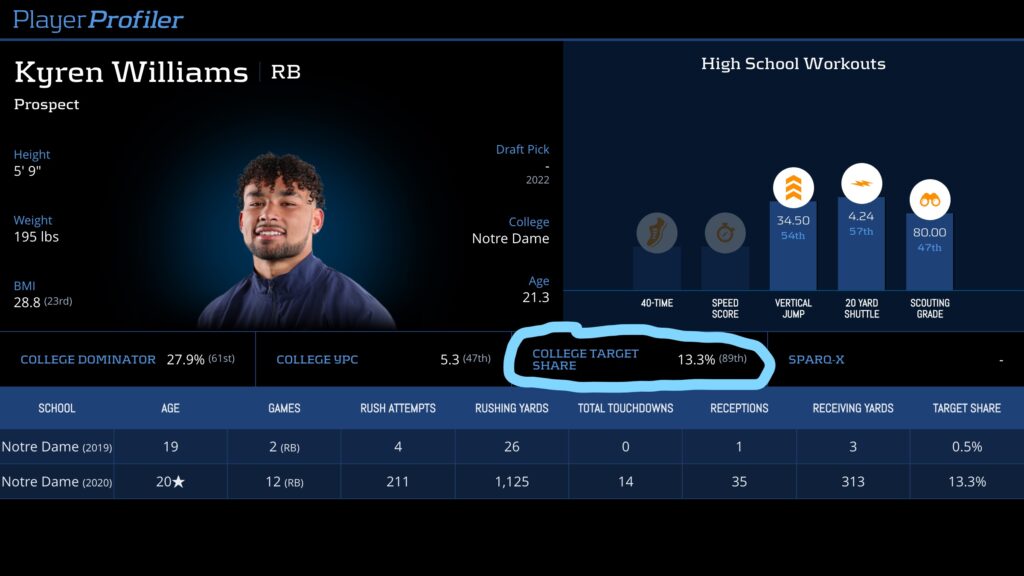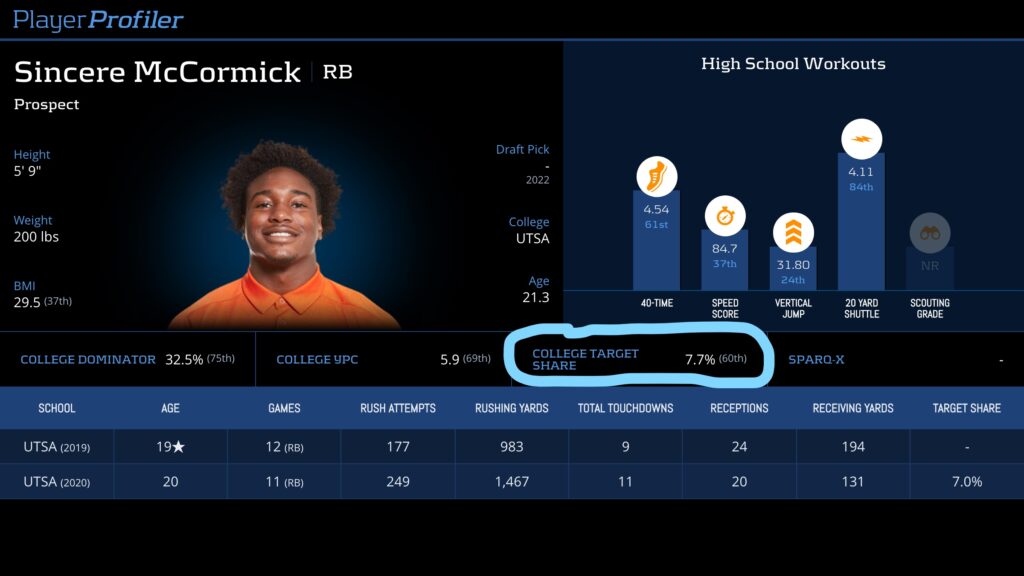
It’s the age-old fantasy football adage that simply rings true: volume is king.
Unfortunately, the dynamic, low-opportunity, high-efficiency supposed stud-in-waiting zooming away from defenders at the bottom of a running back depth chart is a tale as old as time with examples that are a dime a dozen. And what compounds the frustration of seeing that player toil away for nothing is that his counterpart, the high-volume, low-efficiency slug who just gums away at the defenses he’s eating for 20 carries per game, is also a dime a dozen. Who the better player between the two of them in a vacuum is we might never know, but the simple truth is that the slug matters in fantasy football and the dynamo does not.
In fantasy-focused prospect analysis, sometimes what matters more than figuring out who the best players are is figuring out which good players just aren’t the right kind of good.
With that in mind, and with the analysis to follow as the proof in the pudding, my plea to you is this: for the sake of your dynasty teams, stop falling in love with undersized running backs who are not excellent receivers.
SIZE MATTERS
The average size of an NFL running back at the time of their Combine or Pro Day weigh-in is 214 pounds,. And if we classify a “small” running back as one who is less than 210 pounds (mostly because it’s a round number and because a back who is barely below average at, say, 213 pounds, isn’t really that small, Kerryon Johnson is 213 and J.K. Dobbins is 209. So while the less-than-210 cutoff is fairly arbitrary, it makes some intuitive sense, so I don’t really care and I’m going with it), we find that small backs have represented a pretty consistent portion of all pro runners going back more than a decade: 37.8-percent of running backs drafted since 2015 have been sub-210 pounds, and that number is a basically-identical 37.7-percent if we go back to 2007.
Now, if size did not matter, I might still be with Delaney and we would probably see that running back opportunity (and following from that, production) is relatively even on either side of our weight threshold, but that’s not the case. Since 2015 (another arbitrary point I chose because it’s a nice, round number and gives us a decent sized sample), there have been 322 individual seasons in which a running back received at least 100 carries. Among those 322 seasons, 260 of them have come at the hands of running backs who weight at least 210-pounds. Meaning that sub-210 pound runners, a group that represents almost 40-percent of players at the position, were responsible for only 19.3-percent (62 total) of 100-carry seasons in the last seven years. The burden of proof for smaller running backs to earn meaningful volume in the NFL is simply higher than it is for average or above-average sized backs.
This opportunity divide is even more pronounced among running backs who aren’t plus contributors in the passing game. In order to illustrate this, we have to establish what a low-receiving contribution season from a running back looks like. We’ll start with a running backs ratio of targets to carries; among players drafted since 2007, targets have made up 20.3-percent of total running back opportunities (carries plus targets), with the amount of total targets coming out to 25.4-percent the amount of total carries. Basically, for the entire NFL for the past decade-and-a-half, running backs receive one target to every four carries. We’ll say that, in a given season, guys who receive one target to every five carries (in other words, if their amount of targets represents less than 20-percent of their amount of carries) are, relative to size of their own unique role, not contributing much in the passing game. We’ll also say that if you earned at least 50 targets in a given season (again, a fairly arbitrary threshold but right in the Antonio Gibson, Jonathan Taylor range in 2021), your receiving role was sizable enough that you count as having contributed in the passing game regardless of your ratio of targets to carries.
DRAWING TARGETS MATTERS
We’ve now established that a “low-receiving contribution season” is a campaign in which a running back earns fewer than 50 targets and has a target total that does not exceed 20-percent of their carry total. Among the 322 100-plus carry seasons we looked at previously, 145 of them met this criteria as low-receiving contribution seasons. If size did not matter for non-plus pass-catchers getting work on the ground, especially given that we’ve already selected for players who were talented enough to earn at least 100 carries, then we would expect 28 of these 145 seasons (using that same 19.3-percent rate for 100-plus carry seasons coming from small backs) to come from undersized runners.
Once again, the little guys underperform the size of their population. Only 14 of the 145 100-carry, low-receiving involvement seasons come from players sized less than 210-pounds. Meaning that this group that represents 38-percent of all players at the position contributed just 9.7-percent of all such seasons. Further, that means that of the 62 seasons in which a sub-210 pound player totaled at least 100 carries, only 14 of those campaigns (22.6-percent) were posted by a player who was not a sizable contributor in the receiving game. Contrast this with the big guys, for whom more than half of their 260 100-carry seasons (131, for 50.4-percent) were delivered by guys with below-average receiving contributions.
Let’s look at the players who delivered those 14 high-carry, low-receiving seasons from smaller backs, along with their subsequent fantasy finishes (ranked by PPG finish):

The average PPR performance for a low-receiving contribution running back who earns at least 100 carries in a season is 41.9 in season-long finish and 42.6 in points per game finish. The best season for a such a back in the last seven years is either Elijah Mitchell‘s RB15 finish in PPG or Dion Lewis‘ RB13 finish in season-long points. Contrast the ceiling of this player-type with those of two of their counterparts: 210-or-heavier running backs with at least 100 carries and fewer than 50 targets in a season have bested Mitchell’s 2021 PPG output 23 times since 2015. And the small-stature reverse of our archetype (sub-210 pound players with fewer than 100 carries and more than 50 targets: the pure satellite backs) has outdone Mitchell’s 2021 eight times in the same timeframe.

If you’re small, you better contribute in the passing game, and if you don’t contribute in the passing game, you better not be small (and if you’re both, you better play for Kyle Shanahan in San Francisco). Because otherwise the best you can hope for at the very peak of your range of outcomes is high-end RB2 numbers. And you’re far more likely to be an RB4 or worse, assuming you even manage to see the field.
APPLYING TO 2022
So what does this all mean for rookies in the upcoming class? Who are 2022’s tweeners? Those too small to girth their way into opportunity on the ground while also not bringing enough in the receiving game to make it likely they carve out a meaningful role in the NFL, regardless of how dynamic they might be with the ball in their hands?
Luckily, many of the smaller running backs in this class also happen to be quality pass-catchers: Tyler Goodson, Kyren Williams, James Cook, Tyler Badie, Max Borghi, Ronnie Rivers, and Jerrion Ealy are all listed between 185 and 205 on their respective school’s websites (Borghi at 205 is the only one in the group listed above 199), and each of them boasts a Receiving Chops Score above the 60 mark (my process uses a composite of percentile ranks in various metrics to generate composite scores, all out of 100), with Ealy’s the lowest among them at 64.2 (near guys like Josh Jacobs and DeAndre Washington) and Williams the highest at 77.2 (in Charles Sims, D’Andre Swift territory). The overall talent level and pro potential of these guys varies, but I’m confident that they all at least fit the mold of pass-catching backs in the NFL to some degree.

I’m less confident in the prospects of Sincere McCormick, a small school hero with back-to-back 1400-yard rushing seasons who was listed at 205-pounds by UTSA in 2021. At first look, his 66 career receptions (77th-percentile among backs drafted since 2007) seem fine, but the career-high target share of 7.7-percent he posted is just a 35th-percentile figure, which is a problem relative to the quality of program he was playing at (UTSA is obviously not a powerhouse, and their average S&P+ rating — a metric explained here — during McCormick’s time there is in the 16th-percentile for teams of eventual running back draftees) as well as relative to the size of his overall role in the offense.
First, relative to program quality: not all Target Shares are created equal, and the talent that McCormick was competing with for touches in the Roadrunner offense is simply not equivalent to the talent that most drafted running backs competed with for theirs. If he’s not earning a large Target Share against one- and two-star recruits in Conference USA, why should I believe he will do so in the NFL? The burden of proof for small school players is simply higher than it is for dudes playing at blue blood programs, and guys like Aaron Jones and Tony Pollard met that burden while playing at G5 schools by posting target shares above the 90th-percentile. Even dudes like Jalen Richard and Marlon Mack exceeded the 70th-percentile Target Share mark during their time at mid-majors.
Second, McCormick’s Target Share is small relative to his overall offensive production. A given Target Share can be massive for a player who serves a niche role in the offense, while the same receiving involvement might be tiny for a player who is the centerpiece of his team’s gameplay. The college careers of Chris Thompson and David Montgomery are a good example here: Thompson posted a 10.2-percent Target Share at Florida State on a Dominator Rating of just 17.1-percent, while Montgomery posted a 10.1-percent Target Share at Iowa State with a 33.0-percent Dominator Rating. Montgomery’s receiving involvement represents a much smaller portion of his overall role than does Thompson’s, so it stands to reason that Thompson, while perhaps a lesser talent overall, would be more exclusively a receiver at the next level than Montgomery. That expectation holds true with this particular example as well as across the board in general, and I describe this dynamic between Target Share and Dominator Rating with a metric I call Satellite Score (essentially Target Share divided by Dominator Rating), where Thompson scores a 94th-percentile mark of 59.6, while Montgomery scores in the 55th-percentile with a 30.6 showing.

McCormick’s Target Share and Dominator Ratings give him a Satellite Score of 22.4, a 36th-percentile figure, putting him in the same range as two-down backs like Zac Stacy, Derrius Guice, and Gus Edwards. Add that to his average-at-best showings in metrics like yards per reception (25th-percentile) and yards per target (56th-percentile), and it’s difficult to have a lot of confidence in the 205-pound McCormick carving out a role as a receiver in the NFL despite his respectable career receptions total (the composite Receiving Chops Score has him at 41.9).
CLOSING THOUGHTS
If what his profile portends comes to fruition and McCormick does not become an asset in a professional passing game, it’s incredibly unlikely that he is ever a fantasy relevant player, and you can much more confidently bet on him going the way of recent exciting-but-small non-receiver disappointments like Darrynton Evans, Javian Hawkins, and Bryce Love. Shoot your sleeper darts somewhere else in 2022 rookie drafts, and while you’re at, quit holding out hope for Jaret Patterson and Jermar Jefferson, and sell the fuck out of Elijah Mitchell like you should have with Raheem Mostert and Matt Breida before him.


